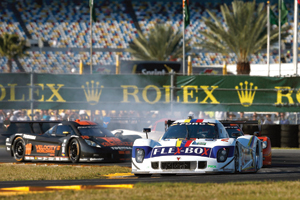The merger of NASCAR’s Grand-Am Series and the American Le Mans Series has invigorated the business of sports car racing by creating a unified series with more manufacturer support, team participation, sponsorship revenue and media promotion than anticipated.
“There’s already been unprecedented growth,” said Scott Atherton, president and chief operating officer of the International Motor Sports Association, the sanctioning body behind the new series. “It’s the healthiest [profit-and-loss statement] I’m aware of in this category, and that’s a testament to the vision of [NASCAR Vice Chairman] Jim France. The fans are going to be big winners here as a result of this merger.”
 |
Last year’s Rolex 24 was the last before Grand-Am and the American Le Mans Series merged.
Photo by: GETTY IMAGES
|
The merger began after NASCAR acquired the American Le Mans Series in late 2012. The acquisition brought an end to more than a decade of competing sports car series. Grand-Am and ALMS spent the last year and a half combining operations, securing sponsorship support, setting a calendar and developing a series of racing classes.
The combined series was named the United SportsCar Championship Series. It held its first race, the Rolex 24, last weekend in Daytona. The race featured four classes: pro-am and GT Daytona Prototype classes, which feature the type of cars in the Grand-Am Series, and pro-am and GT Le Mans classes, which feature the factory BMWs, Porsches, Corvettes and other cars that were showcased in ALMS.
The United SportsCar Series was expected to attract 63 participants for its inaugural race, but it received more than 80 entry applications. It condensed pit space and extended pit lane in order to expand the field from 63 cars to 67 for the race.
“For the first time, we actually have a waiting list to participate,” Atherton said.
The merger allowed NASCAR to eliminate some costs. ALMS closed its office in Georgia and moved most of its staff to Daytona. IMSA also saved money by beginning to use NASCAR’s accounting and human resources staff for support rather than having an independent staff of its own. IMSA’s full-time staff of 35 is 40 percent smaller than the 58 full-time employees who worked at ALMS, which had 33, and Grand-Am, which had 25, before the merger.
In addition to cost savings, the merger allowed IMSA to increase sanction fees for races. IMSA set a 12-race schedule for the season and increased sanction fees between 10 percent and 20 percent for most races and 10 percent for marquee events like the Rolex 24 and Petit Le Mans at Road Atlanta.
Team entry fees were increased “modestly,” Atherton said, because the cost of running a team increased with the new competition specifications.
Combining the series also gave IMSA the ability to increase its sponsorship pricing. It signed a five-year title sponsorship deal last year with Rolex’s Tudor brand. The Tudor deal is valued at more than $2 million a year, considerably more than Grand-Am received from Rolex and tequila Patron paid ALMS annually.
IMSA also kept Patron as a major sponsor by carving out a new presenting sponsorship of the North American Endurance Cup, which includes its four marquee races: the Rolex 24, 12 Hours of Sebring, Six Hours of the Glen, and the 10-hour Petit Le Mans.
The decision to make Rolex’s Tudor brand the title sponsor of the United SportsCar Series was strategic, Atherton said. Had tequila Patron taken that position, it would have been subjected to more federal marketing rules and restrictions placed on alcohol brands, but Tudor isn’t inhibited by that. The brand is using United SportsCar as its primary marketing platform for its relaunch in the U.S. It will begin promotions in earnest at United SportsCar’s third race in Long Beach, Calif.
“They’ve placed their trust in our ability to become the foundation of this relaunch,” Atherton said.
IMSA cut a five-year media rights agreement with Fox last year. Financial terms of the deal weren’t available, but it gives sports car racing its first live broadcast exposure on Fox, which offered two hours of live coverage of the Rolex 24 last Saturday. Other races will air on Fox Sports 1 and Fox Sports 2.
Atherton said the combination of the long-term media deal and sponsorship deals gives sports car racing more stability than it ever enjoyed when it was split between Grand-Am and ALMS. He said the support of NASCAR, which has made IMSA a corporate priority, has been critical to the stability sports car racing has achieved.
“That’s what makes this different,” Atherton said. “Ask Jim France and he would say NASCAR didn’t fully embrace Grand-Am, but the collaboration that’s occurring now is unprecedented.”
Atherton credited NASCAR’s support with helping United SportsCar secure live coverage on Fox and said IMSA staff members have been invited to join senior NASCAR staff meetings for the first time, as well.
He expects United SportsCar to return with a 12-race season next year. IMSA’s growth will come by sanctioning other series, such as the Ferrari Challenge and Porsche GT3 Cup. It will sanction 60 races this year, and he expects it to add more in the future.
“We’re on the threshold of a new era of sports car racing,” Atherton said. “The stability, the sustainability, the positive energy permeates all we do.”





